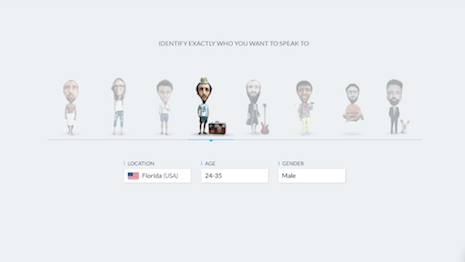By Ray Beharry
To win the hearts and minds of 2 billion elusive mobile consumers, chief marketing officers must make critical moves from customers’ feedback quickly — before the competition does.
In this age of massive data sets and high-velocity decision-making, that means capturing and analyzing customer data and insights in real time.
Gathering direct-customer or focus group feedback used to be tedious and time-consuming. But with real-time information easily available, those tactics are outdated and adversely affect your ability to make critical business decisions.
Consumers access the Internet via mobile more than any other device, which dictates that using mobile is key to reaching them.
Mobile surveys enable direct access to consumer opinions that formerly took months to obtain.
Marketers looking to discover consumer sentiment to gauge the potential success of new initiatives now have a timely way of obtaining that valuable feedback.
Connecting with mobile customers
Companies spend billions on market research to get inside the customer’s head and figure out how to increase sales.
About 10 percent of the $18.9 billion spent globally is allocated to online surveys in the United States alone — that is almost $2 billion.
With so much money at stake, mobile surveys can alleviate a CMO’s pain points when it comes to influencing consumers in their micro moments with relevant content.
Mobile phones are the primary means of communication for nearly six out of 10 Americans. That tethering leads 74 percent of respondents to reply to surveys on mobile, according to an industry report.
It is not hard to see why: Mobile devices generate views.
While a popular – thus advertiser-friendly – television show such as “The Walking Dead” is considered a hit with about 13 million weekly viewers, a mobile application such as Shazam boasts 18.3 million users daily. And its 100 million unique monthly guests continue to visit all year, rather than just seasonally.
What is more, by reaching customers on mobile devices, CMOs can gain honest insights without interrupting everyday life.
When someone receives a mobile survey notification and an incentive for participating, he can provide feedback on his own time, even while on the go. This allows brands to pivot more quickly and improve offerings to serve customers who are not immediately appearing on charts.
Future of customer insights
With so much data available, the real challenge lies in aggregating and analyzing the right data at the right time.
Successful companies will adjust to customer needs by extrapolating insights from small-sample data and applying them rapidly to larger populations.
Imagine running a five-question mobile survey on a new ad campaign in the morning and then using that data to launch the right combination of images, video and copy to the larger lookalike audience by the afternoon. This type of instant personalization is imminent.
And that is just the beginning, as 2016 is hailed as the year of wearables, virtual reality and other Internet of Things technology.
Wearables such as Fitbit and Samsung Gear, designed to gather data and deliver notifications, offer companies a new dimension for interacting with customers.
Moreover, half of all consumers surveyed by CMO.com would provide brands with insight into their lifestyles through wearable data.
By using sensors and other connected device features, companies can seamlessly monitor customer usage data without bothering the customer.
Customers of Progressive Insurance, for example, who use its “Snapshot” device that connects to a car’s diagnostic port to gather driving data, automatically see their premiums adjusted accordingly.
New normal
Web properties already focus on delivering content on smaller screens, and in the next year or two, IoT devices will outnumber PCs, smartphones, and laptops.
That means cars, refrigerators, and even dishwashers will not only report back on consumers’ usage, but also help uncover their inner feelings and emotions.
Such data is like gold for brands looking to provide the products and services that their customers want — exactly when and where they want them.
Just as it is important to develop deep understandings of customers at the start of their journeys, it’s imperative to constantly evolve that knowledge over time.
MOBILE SURVEYS are the first step toward transitioning into this new normal.
With everything from clothes to appliances joining the IoT, and cameras and sensors featured on so many devices, mobile data analytics are the future of marketing.
 Ray Beharry is head of marketing at Pollfish
Ray Beharry is head of marketing at Pollfish
Ray Beharry is New York-based head of marketing at Pollfish, Athens, Greece. Reach him at [email protected].
{"ct":"px0u7BWtinoUjYw60z5trrsE4+\/a19JDjaUEKG++nDsKu9enk+SncCQBy\/EhF0sy5PCpUmKyVVX79RuogFqk9YIJFENpsdtuTh7ifX+30hlw\/xKz6u9yqxOQQ7gUKO9yuN9ckhs5orM8FJ0m9roy02J7xsZn9nk1xFM7jI4ZSUN\/pC9G684NhDa35XzsmXhnKBNj1HNia9B0D0Drn7foZjb8lJAJGZM6mB5ujbVqVpSv8B7Y+WEYlsdXBmaJ\/WLVKdn5o376KvQ1lPniCK0PKkovqQnINXdvThuHhf\/VjawoB6XK8zdPdYc9IbeMZu8XA9XfcT9To4wdKEt\/U4aeir9sff2eH6onApm3\/GzmJ\/im3Ub7+l2HiPqsKF6sxFXGyGbKJuXkehUXFQPUCJdAaFEOrm3xMHTtHuYG0LDES75+QLsCFrhX6DA2NCV8dH3fUo9ZqR5+Y74s1OSiYavYn9Z+fGUaZ7ptD4AXvktfnDfScw8rSLuCRIZz8zLirEMK6uuAVqK2ti2\/zHdL53wn1Kc\/zkWq0xvaZMhkzvJWQk+PQCI0TK9nDgwz5KgvgCitMQ3HKK9\/unvkRf5wSH7qtR4E7j3bOMycsd9BYikvMce9iDa3Bw4\/VD1Jw1utjqr76qkPlY4tKn\/1kw3cZlHvRJoYxzJAQf1YvVwnbyxDrBbUHDClheLRQKR9nDR8Gjoznruw+xAFcClEb7xg1+5De0JlSUVlczXmVg9jX2ptTikR4W\/b\/B15vPI\/3HahD9ZXnMLwjttJtYoq0C28o56uKB2VBlAf4n+mNIbKjjhFm9b81amBCmhSLLcyRcgMVGrgiKFWdWvhyQucEE3lo0ekXF6MrwIza8bYWiyC6x2wt7FHxc5+aNGqY0zfN+fWgvHik3j+uJQjuWMN+jRfSR\/EKtB3OB+8goRjIyQCXsuxcNsNe0LhEz04cmLKUMxFkxh123vYqig1Fj7YdevtlKktNybHlGT190O5nZmvvqVJCccnldxs24RjngMNP1JqwS2ACj+Htt8fy7Wr5UT9fQfjFTevmtN6iuULQjWyLU08BMtKBOC+GUsWcA0pykqkWp\/kQ6MUD\/nXAj0OE0MmQuraGftmPC3Sqy34m+vmghwoD6plWSJ0FL1TYkgwBe2PpbG4c0RR\/IdWoapB5fLXHZ4PDc0BVca0MwoCBE+A\/Dau5YUKspS\/iVULNLDcqpI6\/zmIl1W2LdrdkLF3ndKr1kgSm3aVT6Euvnb3gcMChaLKrhGctf0xF1eeTvVnm2rxaSzGkYeMd9894xDEV77oz\/QhqwJTcEj6EUVcksXYNd+s\/U9rS2xiKuf201uWfqEQVg9d4gjz9lCjxbSPxUYiatZ8ac05dl24VLGWsYtMgppARwN2Xt9kjd0VgjYX44bwXQMHJIdx2l9lAGU7I3hwrhf2Yng9sS\/urt3pGmP2Zk8Fi96Md0T8XMXTPTUBsIiJgfPQLrlcVvsArozyl2TXxV5rgCJt6llnYN5ABE\/Gbu1N1KyIIbsX2NFLXV+MPYoLKYqpVIPj8U+gN6QZbJRWGOEOIY0JA0iDSIQnx1tpF3SbJtpxsZI8fCF0ecCFSosNRUWcV0uviUS2Z9IQtfGmochMlOFWm9mJiL1COrw\/y9G9QQ5SbA\/flxVWEYOy1toR8sv\/NpvUDaOqds4e1j9X4oEVPj\/gGyDFUvjpr47MskxfEOvnWXrT5tBRcZ2tb9k8qiWJCU+ek6r2INEKYg6a090lIr1y10E8Aeyql3Md3KKN1NqA1DCIDg+F7uWoABA5ny3pfGgAGNSzuWVU+CCkTZU5QMY2lU6Z+pLOGYjFqMHDMLc4ZkpE6aO27MNUI19x6EoNYpV2FJOUV3WVuoTHEJ412SCzU7+GQGDmO6UmBsxYNRfM7vvOPiGEFSZEPq3mN23+UHnB0FJXvYMujgRSqhzGzGTI8cTCGCjjpg4hHhmBM+p5TtW2Ofkq8LUCQ4rztZo9OndEXXS7Fm7wFPwDF1K70SaLKKXxgQXrayAHpxrPIjSopqabMdQ4Z9DHVyGD8IuIvMssFoxRdy\/rMr\/hxMYMiBpJWr5rSf8xokI8hV72c6an7NkTqh8QWwewioUw\/wp2FAFN6keaIaGhMuIgKV4JznTNoFZFnBKAvmBpI7frs4pSOkxaIBEw9eNbH5JD7OrEfpkfy0yhjVfDqO44BUQQJJVhtRVjKg5mvYGb1qRZ\/Qm5khAveIehwBqVwNpGkDm\/jEYtuv3d+sLSAq74njAcgxD65XKeukJVIet6Fvq3TOFYMpfhwql5A+fR76Zdjitez76n9nASNTYagQdNOojzy0F\/Rt8PnA1HmRcMC484sfp33y8iu99sio8oqvFgHvpAdZVXmwOHPerW3CHcfWc7vTRlQ1XTpY5JHU+Uq96VfkW23CuzluWH704ZMpw+CYYecJyWnh+ikuL75gu8SD\/VUEwzCOY28O3KHVyVpopmwxy7yZFE0frzbfi2C5Se0108jOKsSw28Fy5SjNpd+ZxGP7w2CsWGVc8kKP560UL6XblOqbR6J+X4Jou7CS02if4zbIPLX+NJaIX\/9Enr62cIcJlI2pNHO\/L5yOdS9lAGCMYCdWCuZl0QgEb3SSnQw0q9+o2vd9ZD8SdDWo9QSveRBwaKQ6MNEYi8nSCW+NqAmmbgnvI5M6DD7BKMqXkvD7Uq1funvZtuB7dZpPJXRSjOCVdgq5D+vjBqfHcN+aLsU2zGZnieoEtQKpwqN6bhDSs6xjYYhRu6ltJ5tgMfkdzM1i6tYzSO+UKQIrnAkky3sSpzzoyo+UiCS2OUtLCBVB1qxsl88Y6oefWkrNrDpgCAvYU0lVowX6Lkaw+Z0cbgR91PvYP80PB+Qg9OC5N5YjnIPRffAKNHCGucVktDDTG1JNc66n57LPC0\/TdU+znS3biwta\/3TvubWTy9JhSu3kIaNuE\/jUKrBYXfRrDCDSd5SEFGmGj5HFIq75KeZCAQ94WB+AL\/Ql0bo89WYQA9dVza88Xhnx2Bl9TcKBotla5RN4wvB9ug3j1vRkAQ7TZKMQpOEVuQWf80KXgsnSgTg0ubg5slQbFoQJt0gXJ8RndeZ5vc5Vx\/n99ymSIv8zV5m0IDbCa15fFmB7hmxfhUIqJLDLin24o1CDsqASzzZE+KHctigteDQBtV4kr\/UzT53\/k0eRQ0yQEuER48CWFpQGr1O0xwP9VYtE1zP1uUb6oBLl1zmaNsbCKPJCsm5GNnVCPqes6xdWk5\/lCreD+oXSthKYmWVdmZmkx\/461fiuY5gqxrz5VHx8K+pHwGEu2GyEsrdLOTDDnIM2JyyxLcYlVjJ2HPy2xjQ6UB25tSVntPKujz4jkndvGa914Ukx0nH88TPppAYPbJoTjTR2L6LUGrc3J\/tcTEE6c5wi3+7C7PYeVQgGnj+sFqr\/aVDhBwIAEFnv\/PUKLLfyh5trm9s8K45PfdDOdecMcwrfxaFBTNhlf2YPE85n7Yl1wV7zTpNs2Hayz+i1JUlVUzugMT3BWPbCgynaCJ25aLBhFOT2WuaStwzf4mABIv4ADVQY\/O5VtamfN+aj\/ouepV6GC5w+kbL8zL\/6ltbrWk38RTKIEpsQp9YfR4yvZsXXHAE9fm0IuK0qwEtY699Yyh9b93bveq4moL4DVB8xa\/UjoYCEWHse7SzlZ5w7Cv2Wx+9DDeeIIri1uuKU4lEwCI5Bgk2bXwxkspC8Dxkm\/CAfpxjO8NNuncz3Uwf\/sXqKhJ2sDYhxBo9BGAevg2h7FbucuRell+ivv\/QeZAo8M+Jyuu6rr7JGXGjPi0D+Fgr+6XnpIYO98wzK663J\/S0aUQgDxkVwoKnoTybsIx33uRHeW5E7N42gE0sUFIwP6JnIxGjSF6ChvkTqgijvBrA+n9FPLklmC\/9P\/peT8GY6CVwGsqOogG2enNhGdcNWhH8qkhsoAwNpE2EYE0sbT8LC0if8JWl\/yECKoiYc+8b0lwOtHs2UqU\/S8Zjucttu7LD9fe+wa0GHOaS\/o6sMIjkApqYZH\/bJ7YoCEMEwWiEEVl6CJSK8AWr4LnPpYPjOIfPhkecx38j5mIvmLB7atZrwo\/yPx2nAN1gTudrphSr8DeZ90LyLjy+rK41RthRRPbPM85NnbOus3AFlhOOY6jQ4d7rWU4QCh8yCs8FfMIZ4InBfg\/JpjmfO0cexE0D7kRajEdstQvzH51yKklugR3x7qSXtZpj9hQ8DEObCpD\/uAAyRm4Q7++YPeglP+xMbK+NOow3K8ZPRnzeGkVZRdX00rXha0+nm1lGWkyslZmVt6g1NGNazQKHVoDyrQ64GuMCHp0WoRunQ9M4endHTVX6S2qw2tt98qQKqwUwZcSCYbyT8ZcgRnZqXKzfKuwe95+OA76o5gYtY\/Zbo3X2YNM6aBovMTj3wutCz2EOl+I46t7j4hXOXtBN1IMJFSzIGIyZm\/vncGaF9uqqlWyZaw9QzGWxtFzJkOmfzuOHbx0E2Q30zTHoiSc\/U8fjN5Wy7bPKv7wGR8yWFqgYf3okjx1GwUHO9DMA7EjRbeg23ncUU8LNgvJHbZZdrcIzo+0orRTmFn2Y\/YN9vD5F2BsYW0XvAQsNNo9J\/JjM7763J1\/XvmZXH3fL5QkRo1QVaaVCt0soOwULP9gQ0gdPjkJQZHZykowRVl2F41k\/U6l8IXK\/UXmcnw4WKiGp4o7jK7ju\/yYpzpa8omrqGJixcR+6UF2rXZkIaHuv3EGqHa180pubwcSyknhlvyiU0+QaVPOG3c9asRwq3KZaUD3NdpOl\/ElM0HV8QQZ\/RVB8ht9hXES3bDimzlumzvSKVnKQRSfnVLXavLllJ89BSTBbKgB24uNUxkB3z5SvnJPIVIlSujnQIK0MvjHcsbA0ViyVDhoZKzCjisl+1u08d++7zs+1cCzVRwf53kw8eAlflsfuCVTiSHAOjxN6w0fuM4TcuZrVg\/Z1a7crApJ26FaKUSnNMmd5SDJYJ31afrp5DOW3MQa6pj3FgQh3m1XgyfsitkONThFZXDqGqjbsXwDSzUGeEtGmt\/wkxGpzR9s1CFG4Mg2asVGsp\/eX+g\/HxgCTz9sCNQ5S8HTyiP9BzpPdcvNLZxD6azjgWFWG8RUWcDWMvc47w+9iFg8+5WqLFN3PDWPHxaqeRDrUEouBgqxq8eokW2ADdQb3JeNKFhCtO0qVVb03XGJtiTwo2r1O\/H0pVzHvvbGa3CXq3wPD0\/xWZ2svQmCncEx3Jsh0fKvPFccq6Jux4J4s\/8DmM9vy8BA4QkZbFp3OwfQfFa8iy7BB\/k9F41ypvOk\/ltyEhPLijYqh3LiP72JO\/scp4+RN+ErEa0dpd4XuUy\/Cy2mk38QV1Uh+\/wyv6zXjABEl0J1wZXBalQ8eNVuGkP5pk+6L\/cMTAxWyWjzdjgY7ZdzeLnU\/DvHxuH69FUFgVKbPMy4hEqMWze7b+14bowzLRiaYVF3J\/+jzj7UxUCLwt+aSysQUPDk9U9P+MtHanSEgmvBctRba1+Am4r6qOLCSU9nmeHTULhqONRVU8lTXEJPDZBO99O8CZtc93rwDWiNTlny2oIMOMr4479+4NUhFW3ykNSdGgIYYWYpdBVt\/xDRSF9n4il+nayIVGfwQM3bFmn1UbiCRD5JIKNW0w84A1AZ97s+gkyWhlG8GVB8lIcp0I1v8jjYmLRkL0PeUJ0wKgaGsUOSRV3MGvY+uGVC0vXh4x6abyVNdwJwywPcMyNqGY4rjRkaM5KZuit4jSB6W63mWxWmWBAQz9ajceKBM4GHXHcdLjeAtER7r6NAPRh7+8Blo0BSFHIvU7PZsc\/\/i3BwMG3JGwIgEVcHRk9+UbmzylYUuUcIEYQUqh7ftXUAcEdDfYYrCyRihE3NF0nku5zZVJWT5NekfNjXxyGKSqmtgaKj1Odm3UvhqDb4VYOOOG2zggPU6\/ZVccbBgJI1p\/VKPjaeWXGJVfAI65SnfJL9zuPMOW3cn5tcwSOwkcw5RhAg8YsqrEtRx6Q4NnPY25WarPUJgRw1N09qVHUYW5H+tjyMJDEmLjCEa6KuVaknDbWryiLB3T2r07KxDryT\/YSQJS\/LzTH8Z79xq+ZBq2bLMxDjwIKkxtfRdkMx4908e5NNMP6GBO2Dft1GEPgoCWMGJi5biWWctzIr+ek9FI7K\/VPCu+czDAtnq18gRMvi+obDI+16efK739tb2Yqpx1yP0GzrXQy9pTOrqJQybG+3TONInscVaekA4CWwLy6ljf5qnvwgzF2eExvuFN25MNQgF3CnQxMOh3dHynrcKwaU\/OjELieBeGZHQ0rR8SjriY2qsrSHNN+A4Sdn5w7OZIR+8PQQlYuvYPYkvkV4XPgwDJtpVy2Ab8DvEQb4brbF3cLTDBCgTBsu9t7VOra+JAlUH3jRnlUpak9J5+8uDRRE16amolBv05JfeMwuofVGXgdV4ViUOA+klZXpSivdoTsQiUv49kFZIX7CWBzM1PHLer\/n4FMnmTLde5fa6ZU\/vmh1NYNDRwGz4eBZjFeN6So4FbmHyGjOOCXFeERTALST3blkpM4cCFm\/v3rzbgYjRmTe8CWLtJr5VJ9V\/egPccaJrvgLJuRuuV4hrC+AZzJdn1lJ480+cW5cdSMKs3Iddva0fSX0m\/5BdCXiZYIK5bGT0OsQTqOjUJiwAjSwT19X75UoF08mtM\/Cb+iO55+0vagvTchDe2PgO\/jAgWr6TkduBzdg6X9gRsf7qmn3tGANDWDBo2qfO2r30K4IZf2S8+g2RNBvFkdABlcEuk7QDIiLtLEc8kyZN47Zx6Ng3lZCf2rky+DlYEMjEFPf38jfUoIp847AG4uqGEsBCbr9jzbbuuLHRemvbISSpDCbFPXAFbdfHWQIS8RMAgzc\/vKMV4RnBcG\/1pC8L2TK3hV0uTqd0ZTRpaVX3jTPlAZREPUvsS0XaqooVMT5gBvSHqzWVHtRczPhYVI0PQ9DVn+s9bCNyRB\/ILwljTNM4Fpb8ds0f\/j4cDQU2y2CfY0uwC2us5FcAK\/z2rFXzECrDWWZdtXB3cuLJLH\/xC70mANlDNmXIu434Vat\/uIQC982Qhv1H\/tSFN2ivyMcdboDxjxKlGUyWZhk\/\/ZYV5Q6XF2qqFZqN4DU2SpX5UgU4dOsbpFIzncM+yM4M1TPJvv3bGUZwxZvIl+2s\/E186uN\/BD87znEZvOOtrOdKO4z0\/m9apBX+Fj3V9Ag58CTTAvLI1RPDSN1dbqQ+CkMRE\/mf4Za8BeZmwtpA9leatoyyUcOBQkPrf5yXOQ3kdPTc9CdCWQiq\/b4l8DfG4lZpKzMhbQFdcAGXZoucOwNkdWQ6+sMlkZyzVyX56x0vVBBmNfxwLyBfvG5cqtB1IA\/YFbj0YuvxuvwqsbLLtdiqutcvsL0xiwg5HlvXC2hkcWz4yBx+Xo5bPi8gsi4krHcwfh1LRoNpB8msQ2E\/5zVtbyOa8YLDxf6PXg7OPTwkw1Fh1wvJigx9Qr+A7X1qXIEt9UUfe8RDrhQaXO67ik5Bllziw36UK\/N2HRu+lSy8Xz5WVwG01tGSZWtl+LrDUzUltoaKLQ7F7re6oV4ZlHkACMeUGMYn7gtpZiDgasUq14BYhAxIIb5RS8OjE3xOqNVWarPM9zRr9bohGm4NKGtmisbq3PZBG2vflM=","iv":"290796b267a2f29a33187fc864c13be1","s":"43c97c15abcd6f33"}

 Standing in for many
Standing in for many
 Ray Beharry is head of marketing at Pollfish
Ray Beharry is head of marketing at Pollfish